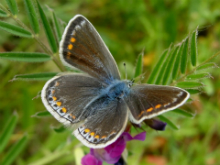%20030814_DM_43.jpg)
Widespread and common


Distribution and Status
The Common Blue is widespread and common in our branch area although it is absent from the some of the more urban and agricultural areas. Although populations are a little lower than 30 years ago it is colonising new sites after a lean spell at the turn of the century. However, 2020 and 2021 saw alarming declines in abundance although there was a partial recovery in 2022.
Habitat Requirements
Open grassy areas especially where the larval foodplant Common Bird's-foot Trefoil Lotus corniculatus grows
Larval Foodplants
Common Bird's-foot Trefoil Lotus corniculatus. [Greater Bird's-foot Trefoil L. uliginosis on wetter soils, Lesser Trefoil Trifolium dubium, Black Medick Medicago lupulina, Common Restharrow Ononis repens]
Adult Food Sources
Common Bird's-foot Trefoil L. corniculatus, Garden Lavender Lavandula x intermedia, Heather Calluna vulgaris
Behaviour/Observation notes
The female Common Blue can look very much like a Brown Argus. Aside from the different spot patterns on the undersides for the two species, the best way to distinguish between them, another clue is the flight behaviour. Brown Argus is usually more skittish and appears silvery-grey whereas the female Common Blue makes slow flights between resting/nectaring and looking for places to lay her eggs

Life History
There are two broods every year with the second generation usually seen in greater numbers. Peak numbers are often recorded in the last week of May and first week of June for the first brood, and early to mid August for the second generation. In warm years there may be a partial third generation as occurred in 2018. Females lay eggs on the leaves on which the caterpillars feed underneath. Larvae attract the attention of ants when fully grown. Pupae are formed on the ground, sometimes close to ants' nests. The butterfly overwinters in the larval stage
Further information
Photo gallery
Branch Annual Report (2022)
UK distribution map
Full list of larval hostplants (Lycaenidae)
Stevenage butterflies - additional notes